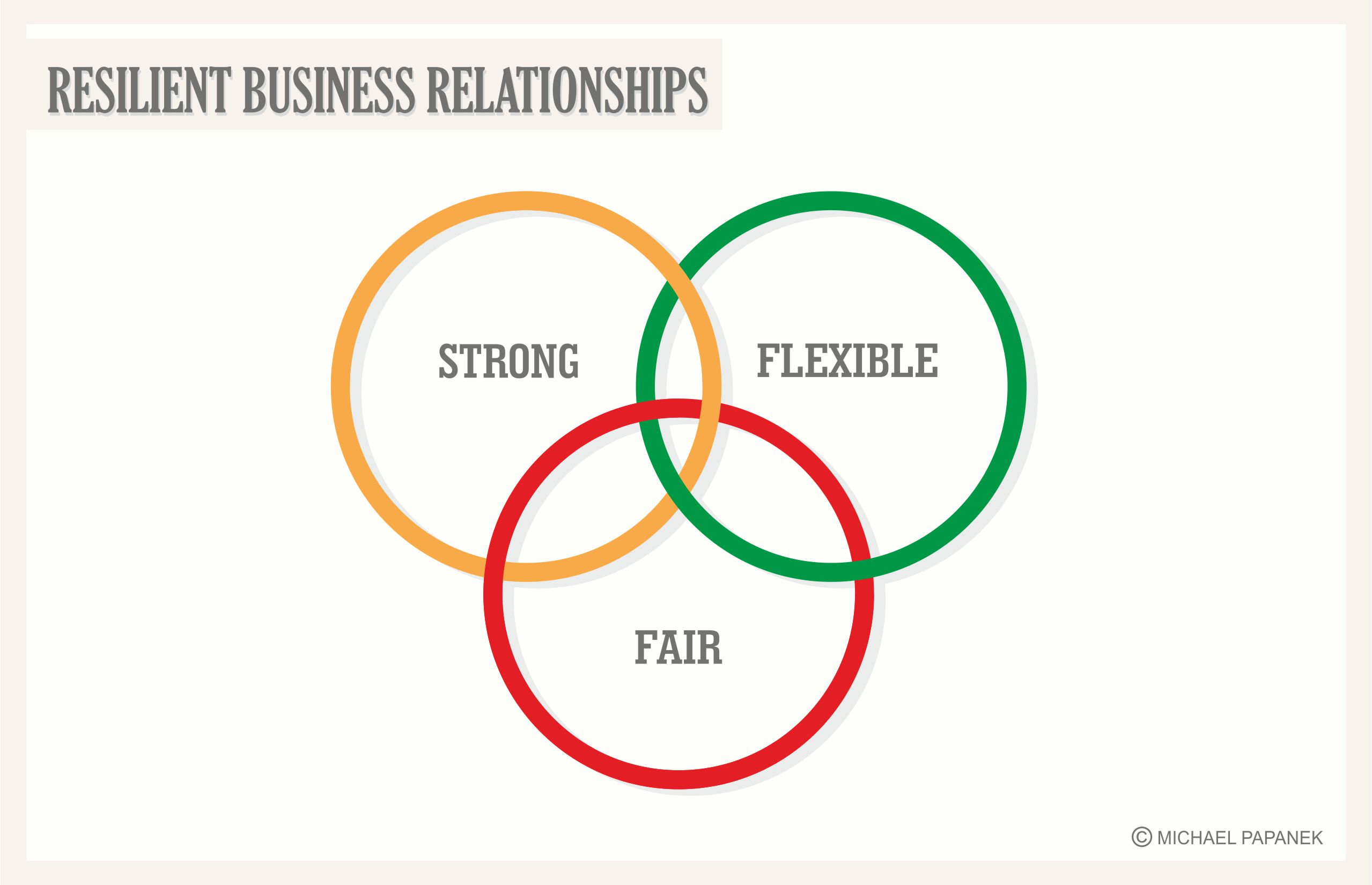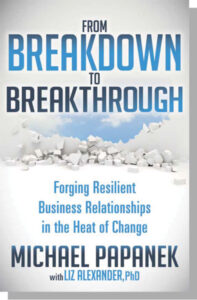From Breakdown to Breakthrough
Business leaders often focus on profits and metrics, living in spreadsheets and analytics. But what drives these results is people and relationships. So often it’s the resilient relationships, those that are forged in uncertain and difficult times that make the difference.
Author Michael Papanek takes three decades of experience with clients ranging from Apple to Google and shares it in his new book, From Breakdown to Breakthrough: Forging Resilient Relationships in the Heat of Change. His framework helps leaders develop the confidence to take these relationships to the next level. I recently asked him about his work.
Build Strong Relationships
What are the elements of a strong relationship?
A strong business relationship will have a number of attributes that set that relationship apart from others. First, it must provide value to both parties, and it is “generative,” meaning the value together is more than any one person could create on their own: so that 1 + 1 = 3. Strong relationships also create multiple tracks of value that would be hard to replace if the relationship ended.
One example of this is from the entertainment world, where the band the Grateful Dead was famous for their long relationship with their very loyal fans (which continues today, long after the passing of their leader Jerry Garcia). In addition to music, the band created value in other key ways for the fans, such as supporting a community of fans (the “Dead Heads”) as well as creating an ‘outside the concert’ experience, and even income for some fans (by selling items at the shows).
Finally, a strong relationship contributes to key strategies or needs of each party. Relationships that do not create value this way may be categorized as superficial and easily ended. If you are ever not sure if the business relationship is really strong, that is the time to discuss it. Do not wait until you are surprised by a change.
How often do our relationships hit that sweet spot between strong, flexible and fair?

Not often enough! We may feel pressure for short-term revenue or growth and fail to invest in resilient relationships and only find out later, when they fail under pressure, that the relationship was not in that sweet spot of resilience. I have found that the further one goes in his or her career, the more one realizes the important of relationships for sustained success, and the more we choose whom to work with.
My hope would be that each person builds more and more resilient business relationships over time, so that eventually he or she has almost no relationships which are not strong, flexible and fair.
Tell us about the heat curve. How was it developed and how is it used?
The heat curve was developed in part from research at Stanford Business School from their use of “T-Groups,” where business students would form smaller groups to experience and study group dynamics. The “T-Group (“T” is for “training”) was originally developed by Kurt Lewin, my grandfather, in the 1940s as part of his (with others) founding of the study of Organizational Development. I used that research as input to my own studies of how teams, especially leadership teams, handle conflict and disagreement and how that impacts decision-making, innovation and resilience.

The Heat Curve is used to understand and improve any team’s ability to use “heat” and conflict rather than avoid it. Noticing and changing the team’s Heat Curve will help the team deal with the harder and more strategic issues they must address to move forward. The goal is to shift the curve up and to the right by using ground rules, smart agenda design, clear roles (such as facilitator vs. leader) and honest and open feedback.
Don’t Have “Nice” Meetings
What are some of the dangers of “nice meetings”?
 There are many problems with nice meetings, but first we must be clear on what we mean by “nice.” The goal is not to have a “mean” vs. “nice” meeting. But when being nice means not telling the truth or avoiding difficult issues, the danger is those issues either go unresolved (and get worse with time) or they are addressed “off line” in a more political or hidden way. Some organizational cultures value “nice” so much they let differences of point of view go unsaid.
There are many problems with nice meetings, but first we must be clear on what we mean by “nice.” The goal is not to have a “mean” vs. “nice” meeting. But when being nice means not telling the truth or avoiding difficult issues, the danger is those issues either go unresolved (and get worse with time) or they are addressed “off line” in a more political or hidden way. Some organizational cultures value “nice” so much they let differences of point of view go unsaid.
All innovation comes from difference; so the danger is that people can be so “nice” to each other that they lose in the marketplace because they never deal with the real or most important issue or idea. If something is not working, and we cannot discuss that because someone might take it too personally. Then we cannot really make the changes we need in time for those changes to matter. Finally, too nice a meeting can mean the meeting was a waste of time.
As a consultant working with many executives in various fields, what are some of the common pitfalls you notice most executives making?
One common pitfall is the belief that if you are right, it gives you the right to be a jerk! Just because we have the right answer does not mean we do not need to show respect for others’ points of view. The best leaders allow for some give and take, so that others have buy-in and ownership over the result and are not just following orders. When people are part of the vision they work harder and give us their “discretionary effort” rather than the minimum they need to do to keep their jobs. Too many executives “win the battle but lose the war” because they have too strong a need to be the smartest person in the room.
What makes an organization resilient?
Organizational resilience is the sum of all the key relationships that the organization has. These tend to be between leaders and their team members, between the organization and its customers, and with key partners and suppliers.
I suggest leaders take an “inventory” of their key relationships and assess each one across the three dimensions of strong, flexible and fair and see how resilient they are. The organization could lose very quickly and come apart under the stress caused by changes by competitors and in technology.
Create a Culture of Resilience
What does the leader do to create this type of culture?
The leaders I interviewed each display different ways they have built a culture of resilience in their organizations. Leaders create this kind of culture by balancing their focus across the three dimensions of strong, flexible and fair in all their work, from hiring and performance reviews to pricing and partnership decisions.
Leaders should practice an “I’ve got your back” value system, where the leader always supports his or her team: “giving the credit and taking the blame.” Look for opportunities to delegate, and make sure to share decision-making to create buy in. Finally, asking for (not just giving) feedback will create a culture of resilience and openness so your organization can continue to succeed even under change and stress.
Let us help you innovate YOU! By signing up for FREE to Leadership Insights, you will have a positive stream of insights to reimagine your future! Plus get Skip’s free leadership book and digital seminar on creativity.subscribe]
For more information, see From Breakdown to Breakthrough: Forging Resilient Relationships in the Heat of Change.

